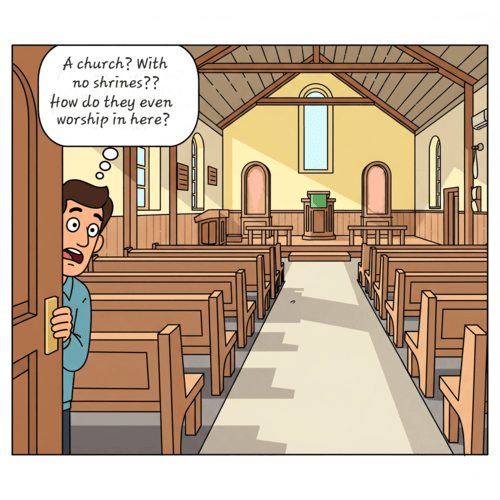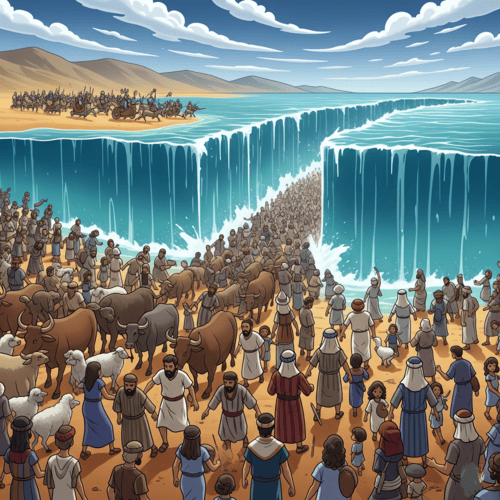Debate on Creation Days: Is Exodus 20:11 the Jury’s Verdict?
In the ongoing debate about creation days and the age of the earth, one Bible passage stands as a towering verdict that old-earth proponents often sidestep: Exodus 20:11. As part of the Ten Commandments—among the most significant texts in Scripture—God Himself declared: “For in six days the LORD made heaven and earth, the sea, and all that is in them, and rested on the seventh day.” This isn’t merely a passing reference but a divine pronouncement embedded within moral law. It’s the jury’s verdict on the creation debate, yet strangely remains one of the most overlooked texts by those arguing for creation periods spanning millions of years.
THE SABBATH COMMAND: GOD’S TIMESTAMP ON CREATION
The Fourth Commandment fundamentally links human practice to divine example. God commands a weekly rhythm of six days of work, followed by one day of rest precisely because this pattern mirrors His own creative activity. Consider the explicit reasoning:
“Remember the Sabbath day, to keep it holy… For in six days the LORD made heaven and earth, the sea, and all that is in them, and rested on the seventh day. Therefore the LORD blessed the Sabbath day and made it holy.” (Exodus 20:8-11)
This connection creates an insurmountable problem for old-earth interpretations. If God’s “days” were actually long ages spanning thousands or millions of years, the parallel completely breaks down. How could God command us to work six ordinary days based on His six “ages” of creation? The comparison would be meaningless. The logic only holds if God’s creative days were the same type of days we have.
Exodus 31:17 reinforces the connection: “It is a sign forever between me and the people of Israel that in six days the LORD made heaven and earth, and on the seventh day he rested and was refreshed.” Again, the Sabbath institution is explicitly grounded in God’s creation timeline.
THE CLEAR MEANING OF “DAY” IN GENESIS
When we examine Genesis 1, several linguistic features confirm the author intended readers to understand literal 24-hour days:
- The Qualifiers “Evening and Morning”: Each creation day concludes with “there was evening and there was morning, the [number] day.” Throughout Scripture, this phrase consistently denotes a normal day-night cycle.
- Numerical Adjectives: In Hebrew, when “yom” (day) appears with a numerical adjective (first, second, third, etc.), it invariably refers to a literal day. This rule holds true in over 350 instances throughout the Old Testament.
- The Context of Genesis 1-2: The creation account establishes time cycles that still govern our world—most notably the seven-day week, which has no astronomical basis but persists globally as a testimony to creation.
HISTORICAL UNDERSTANDING: A RECENT DEPARTURE
Throughout most of church history, both Jewish and Christian scholars understood Genesis to describe a literal creation week. From the ancient rabbis to the early church fathers to the Reformers, the overwhelming consensus interpreted Genesis 1 as describing six ordinary days.
The shift toward interpreting creation days as long periods emerged primarily in the 19th century—as a response to new geological theories, rather than from fresh Bible insights. This historical fact should give us pause: Are modern reinterpretations driven by the text itself or by external pressures to harmonise Scripture with current scientific theories?
PROBLEMS WITH NON-LITERAL INTERPRETATIONS
Those who reinterpret “days” as long ages create numerous textual problems:
- Plants Before the Sun: Genesis has plants created on Day 3, but the sun only on Day 4. This sequence is problematic if days represent millions of years—how did plant life survive long ages without sunlight?
- Death Before Sin: Old-earth views typically place animal death, suffering, and extinction before human sin. Yet Romans 5:12 states death entered the world through sin, and Genesis 1:31 describes the completed creation as “very good.”
- Textual Inconsistency: If “day” means “age” in Genesis 1, why does the same word clearly mean a literal day in contexts like Genesis 2:17? Consistent hermeneutics should lead us to interpret the same word similarly in the same literary context.
COMMON OBJECTIONS ADDRESSED
Sceptics often cite 2 Peter 3:8 (“with the Lord one day is as a thousand years”) to justify non-literal days. However, this metaphorical statement about God’s timelessness doesn’t establish a mathematical conversion formula for Genesis. That passage actually emphasises God’s patience, not creation chronology.
Others suggest Genesis uses “anthropomorphic” language, describing creation in human terms. But anthropomorphism doesn’t negate the plain meaning of time references, especially when those time references form the basis for human institutions such as the Sabbath.
DEBATE ON CREATION DAYS: THE VERDICT STANDS
Exodus 20:11 doesn’t merely suggest creation happened in six literal days—it enshrines this truth within moral law. It represents God’s own testimony about the timeframe of His creative work, directly connecting our weekly cycle to creation’s original pattern.
When we allow Scripture to interpret Scripture, the case for literal creation days appears not just plausible but overwhelmingly convincing. The linguistic evidence, the historical understanding, and most crucially, God’s own declaration in Exodus collectively form a verdict that stands the test of time.
The debate on creation days is over. The divine Judge has spoken in Exodus 20:11. The jury has returned its verdict. The only question that remains is whether we will accept it.
DEBATE ON CREATION DAYS: RELATED FAQs
How do Young Earth Creationists explain the apparent age of the universe and geological formations that seem billions of years old? Many features of our world may appear old because God created a mature, fully-functioning universe from the beginning. Just as Adam was created as an adult rather than an infant, geological features were created with the appearance of history and development. Additionally, catastrophic events like the global Flood described in Genesis would have dramatically accelerated geological processes that uniformitarian science assumes took millions of years, creating features in days or months that would otherwise require vast time periods.
- What about distant starlight? How could light from stars millions of light-years away reach Earth if the universe is only thousands of years old? Several scientific models have been proposed to address this, including the possibility that God created light already in transit (showing the entire cosmic history), or that gravitational time dilation during creation week caused time to flow differently across the universe. Another possibility involves changes in the speed of light or the one-way nature of light’s travel that wouldn’t be detectable by our current scientific instruments. The fact that we don’t have all the answers doesn’t negate the clear teaching of Scripture about creation’s timeframe.
- How do Christians reconcile Noah’s Flood with the fossil record, which shows distinct layers and apparent succession of species? The global Flood described in Genesis would have caused massive sediment deposition in a short time, sorting organisms largely by ecological zones rather than evolutionary development. The apparent succession we observe often reflects the burial order of different habitats—marine creatures buried first, followed by lowland habitats, and finally upland ecosystems. Additionally, more mobile creatures would naturally seek higher ground during rising floodwaters, explaining some of the sorting patterns we observe in the fossil record.
If the earth is young, how do you explain radiometric dating methods that consistently yield ages of millions and billions of years? Radiometric dating methods rest on several unprovable assumptions: that initial conditions are known, that decay rates have remained constant throughout history, and that systems have remained closed. Evidence suggests decay rates may have been accelerated during creation week or the Flood, and experiments show extreme conditions can and do alter decay rates. Additionally, when tested on rocks of known age (like recently formed volcanic rocks), these dating methods often yield wildly incorrect dates, suggesting their fundamental reliability for ancient materials should be questioned.
- How should Christians respond when surrounded by ridicule and the overwhelming scientific consensus supporting an old earth? May we remember scientific consensus has been dramatically wrong many times throughout history, and paradigm shifts often begin with minority positions. Stand firmly on Scripture’s authority while remaining humble about human interpretations of both Scripture and scientific data. Let’s seek to educate ourselves about both the biblical and scientific evidence for young-earth creation so we can engage thoughtfully rather than fearfully. Most importantly, let’s recognise this issue ultimately concerns the reliability of God’s Word—if we reinterpret Genesis to accommodate current scientific theories, where do we stop reinterpreting Scripture when it conflicts with popular opinion?
- Doesn’t the presence of animal fossils showing evidence of disease, suffering and predation contradict the idea that death only entered the world after Adam’s sin? The Bible specifically states that death entered the world through Adam’s sin (Romans 5:12), and the original creation was “very good” (Genesis 1:31). The fossil record, with its evidence of cancer, thorns, and carnivores, must therefore represent the post-Fall world, not the original creation. Most of the fossil record likely formed during Noah’s Flood and subsequent events, representing organisms that lived in the violent, fallen world. This understanding preserves the theological connection between sin and death presented in Scripture.
If Genesis is meant to be read literally, how do you explain the apparent literary structure and parallelism in the creation account? Literary structure and historical accuracy are not mutually exclusive in ancient Hebrew writing. The creation account indeed contains beautiful literary patterns, with Days 1-3 establishing realms (light/dark, sky/sea, land) and Days 4-6 filling those realms (sun/moon, birds/fish, animals/Adam and Eve). This orderly structure reflects God’s systematic work but doesn’t negate the historical nature of the account. Scripture often presents historical events in aesthetically pleasing literary frameworks—consider the chiastic structures in historical narratives throughout the Bible that don’t diminish their historical accuracy.
DEBATE ON CREATION DAYS: OUR RELATED POSTS
- Can a Young Earth Explain Impact Craters? Evidence Says Yes
- 6000 Years Or 4.5 Billion: How Old is the Earth Really?
- Do Tree Rings Really Prove the Earth Is Old?
- Mt St Helens: How One Volcano Challenges Geological Timescales
- Population Math: The Overlooked Evidence for a Young Earth
- Age of the Earth Discussions: How’s Helium a Gamechanger
Editor's Pick

Self-Authentication: Why Scripture Doesn’t Need External Validation
"How can the Bible prove itself? Isn't that circular reasoning?" This objection echoes through university classrooms, coffee shop discussions, and [...]

Do Christians Need Holy Shrines? Why the Reformed Answer Is No
Walk into a medieval cathedral and you'll encounter ornate shrines, gilded reliquaries, and designated "holy places" where pilgrims gather to [...]

I Want To Believe, But Can’t: What Do I Do?
"I want to believe in God. I really do. But I just can't seem to make it happen. I've tried [...]

BC 1446 or 1250: When Did the Exodus Really Happen?
WHY REFORMED SCHOLARS SUPPORT THE EARLY DATE Many a critic makes the claim: “Archaeology has disproven the biblical account [...]

Does God Know the Future? All of It, Perfectly?
Think about this: our prayers tell on us. Every time we ask God for something, we’re confessing—often without realising it—what [...]

Can Christian Couples Choose Permanent Birth Control?
Consider Sarah, whose fourth pregnancy nearly killed her due to severe pre-eclampsia, leaving her hospitalised for months. Or David and [...]

Bone of My Bones: Why Eve Was Created From Adam’s Body
"This at last is bone of my bones and flesh of my flesh!" Adam's joyful exclamation upon first seeing Eve [...]

Is Calvinism Fatalism in Christian Disguise? Think Again
We hear the taunt every now and then: "Calvinism is just fatalism dressed up in Christian jargon." Critics argue Reformed [...]

Can Churches Conduct Same-Sex Weddings?
In an era of rapid cultural change, churches across America face mounting pressure to redefine their understanding of marriage. As [...]

Gender Reassignment: Can Christian Doctors Perform These Surgeries?
In the quiet of a clinic, a Christian physician faces a challenging ethical question. A patient sits across the desk, [...]
SUPPORT US:
Feel the Holy Spirit's gentle nudge to partner with us?
Donate Online:
Account Name: TRUTHS TO DIE FOR FOUNDATION
Account Number: 10243565459
Bank IFSC: IDFB0043391
Bank Name: IDFC FIRST BANK






